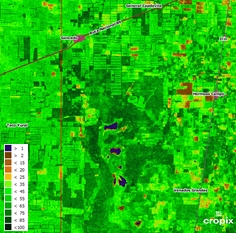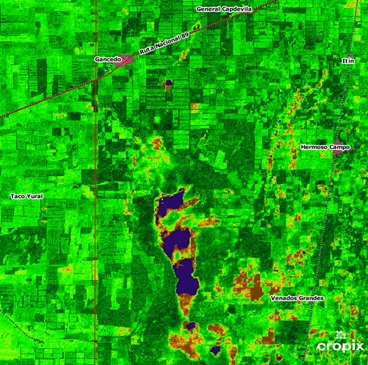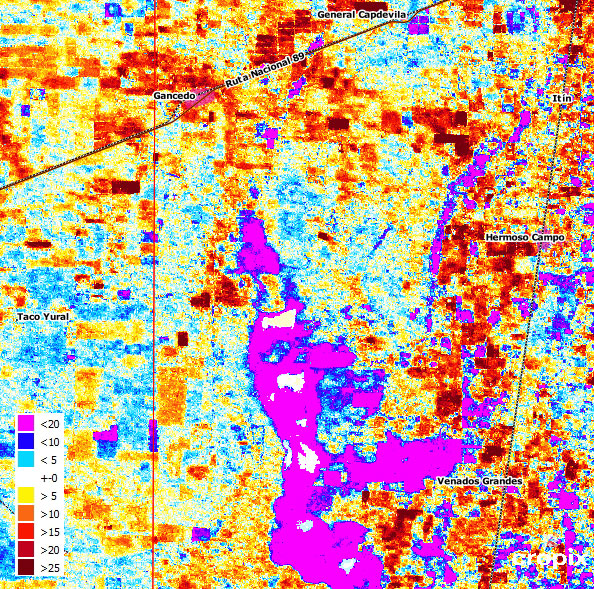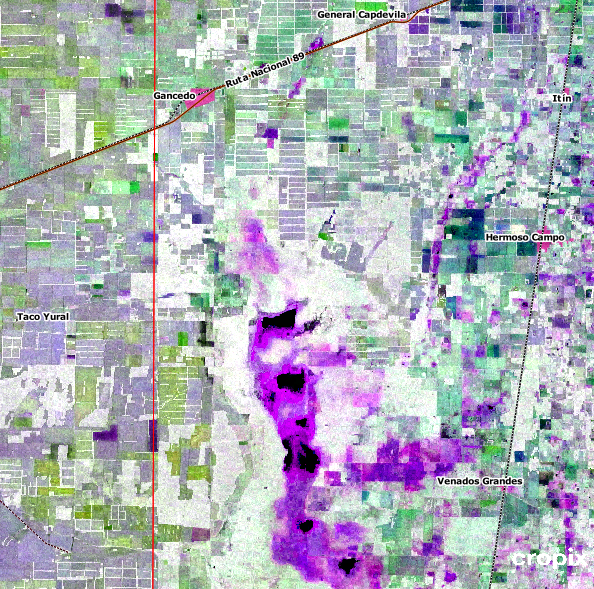Last February, Argentina was struck with a severe storm that caused floods and damage. Data from the Copernicus Sentinel-1 mission helped to map the event, in ways which could assist crop insurers with occurred losses.

Having data that can assist in mapping floods and the extent of damage incurred by them could help insurances to estimate the needed reserves in an early stage, because often loss adjusters cannot enter areas when they are flooded.
On 14 February 2020, a storm caused heavy rainfall in some areas of the Santiago Estero Province in Argentina. Roads were blocked and croplands flooded, which caused some damage.
An agency in Argentina confirmed that National Route 89 was closed at the location of La Paloma, near Gancedo, for safety reasons when the road became covered with water.
Roberto Gagliardi from Cropix wanted to highlight the extent of the flooded area using data from the Sentinel-1 mission of the European Union's Copernicus Programme.
The Copernicus Sentinel-1 mission gives unprecedented coverage and continuity of data, which is extremely important for monitoring water transfer dynamics and helping experts to evaluate its influence on fauna and flora, as well as tracking the presence of partially submerged vegetation.
The repetition of data acquisition in this region is 12 days for the descending orbit D039. The second orbit that passes the area every 12 days is the ascending orbit A003. The first image from the time-series shows the Enhanced SAR Vegetation Index (ESVI), which is an index for fresh biomass, from 9 February 2020 (D039), which was 5 days before the event.
The ESVI shows fresh biomass in green, bare soil condition or very low vegetation in brown, and water bodies in blue. The next acquisition from 18 February 2020 (A003), which is already four days after the event, still shows where water flooded the road flowing into the lowlands.
The ESVI gives us a view of the actual situation based on a static colour-coding scheme.
The next image indicates the change between the two acquisitions from 9 February and 18 February 2020, based on ESVI. We see a significant drop in value, but the data still indicates the area is flooded. With such maps, insurance companies could see which area was flooded as soon as five days after the event.
Easier to perceive is the flood evolution map, which shows three ESVI maps merged to a colour composite. The dates are 28 January, 9 February and 21 February 2020 (D039), where blue areas represent flooding.
Cropix researchers combined three ESVI values to a colour composite and easily detected where the water passed by.
Such map products could help crop insurers and farmers to estimate the damage and reimbursement earlier than traditionally has been possible, when relying solely on in-situ assessments.
"In such times we must prove our business processes whilst facing current situations, as with the COVID-19 virus. We have learned that not only financial services are system relevant, but agriculture is as well. Remote sensing may be the interface between both and the Copernicus Sentinel data can make a huge impact in this respect", affirms Dietrich Heintz, CEO at Cropix.
About the Copernicus Sentinels
The Copernicus Sentinels are a fleet of dedicated EU-owned satellites, designed to deliver the wealth of data and imagery that are central to the European Union's Copernicus environmental programme.
The European Commission leads and coordinates this programme, to improve the management of the environment, safeguarding lives every day. ESA is in charge of the space component, responsible for developing the family of Copernicus Sentinel satellites on behalf of the European Union and ensuring the flow of data for the Copernicus services, while the operations of the Copernicus Sentinels have been entrusted to ESA and EUMETSAT.

